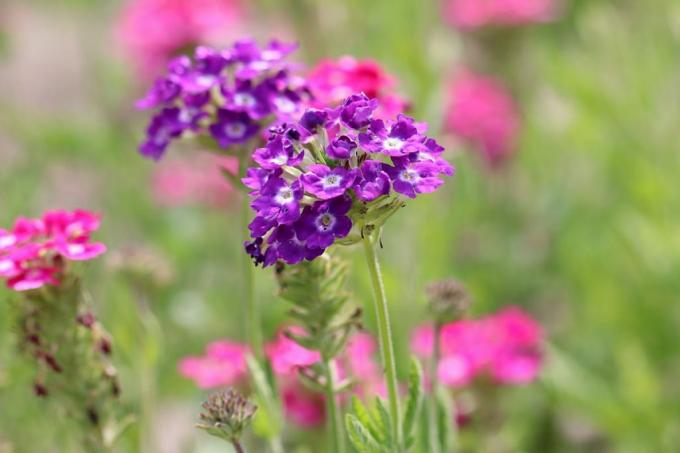
table of contents
- Appearance and stature
- Location requirements
- Soil condition
- Cultivate in the bed
- Bucket cultivation
- frequently asked Questions
In order for the verbena to thrive and to form its many small decorative flowers, the plant needs both optimal care and the ideal location. What this looks like is explained in the article.
In a nutshell
- best location conditions in full sun and sheltered places
- a shady location is at the expense of the flower
- Verbena is not hardy
- Soil quality permeable, light and moist
- Can be cultivated in a tub or in a bed
Appearance and stature
There are different types of verbenas (Verbena) which belong to the family of Verbena family belong. Therefore, the term verbena is not uncommon when referring to the verbs. Some species grow upright, others crawl across the ground:

- herbaceous plants
- always annual
- Subshrubs
- from creeping up to four feet tall
- Flowering from June to October
- all flower colors except yellow
- give off a spicy scent
- The stem is square
- The leaves are serrated
Location requirements
Even if the verbena is considered to be relatively undemanding, it has very specific demands on the chosen location. Because, in addition to the care, this decides how many flowers are formed:
- full sun
- sheltered from the wind
- new breeds can also cope with wind
- light penumbra is still accepted
- warm place guarantees abundant flowering
- no problem with great heat

Note: If the verbena comes to a shady place, it is unlikely that the plant will develop flowers. Because the darker it is at the chosen location and the less sunlight falls here, the worse the site conditions are and the sooner the verbena flowers fail.
Soil condition
The nature of the soil in the chosen location is also important for the plants to thrive and for abundant flowering:
- light soil
- always moderately moist
- Avoid waterlogging, however
- Mix heavy clay soils with gravel or sand
- Soil becomes more permeable
- pH should be slightly acidic
- but a neutral soil is also assumed
Cultivate in the bed
The annual verbena can of course also be grown outdoors. It becomes particularly decorative when different types of verbena with many different flower colors find a place together. However, you have to pay attention to the height of growth so that no tall plants overgrown the creeping ones:

- in the sunny front yard
- in a sunny rock garden
- Cottage garden is ideal
- in front of a low fence
- as a bed border
Note: If you want to plant the decorative plants on a grave, there should definitely be light shade here. Unfortunately, these site conditions are often not given in cemeteries.
Bucket cultivation
It can make sense to cultivate verbena in a bucket or window box in the local latitudes. Because the pot with the verbena can always be placed in the right location:
- pre-fertilized, ordinary potting soil is sufficient
- sunny place on the balcony or terrace
- a south-facing balcony is ideal
- a terrace facing south
- creeping varieties in a hanging basket
Tip: If the vessels with the verbena are to find a place on a covered terrace, then Sie place them as close as possible to the exit to the garden. With a covered balcony, it is advisable to hang the pots on the balcony railing
frequently asked Questions
Since the plants in our latitudes are cultivated in the bed are annuals a change of location is not advisable if it is cultivated in a shady garden bed became. Here it makes more sense to cultivate the plants in a full sun bed for the next year. Plants in the pot can be rearranged at any time. However, this should be done slowly, step by step, so that the leaves do not burn immediately if they come into contact with the sun after a long period in the shade.
Since verbena is an annual plant, it dies with the first frost. Therefore, it is not necessary to protect a plant cultivated in a bed from winter. Plants cultivated in pots can, however, be moved to a frost-free, light and not too warm place in order to overwinter them here. However, overwintering is usually not worthwhile, as the plants are then over the years and thus become blooming. However, cuttings from late summer can be overwintered.
This is of course possible, the plants will grow here even without much sun. However, in such a case you have to put up with the fact that the flowers are smaller. Verbena is originally at home in South Africa and therefore gets along best with the climatic conditions there.
The decorative plants can be cultivated alone or together with many other plants. Straight window boxes look particularly beautiful when they are filled with a mixture of verbenas, begonias (Begonia), Magic bells (Calibrachoa), vanilla flowers (Heliotropium arborescens) and Petunias (Petunia) to be planted. In a mixed culture, attention should always be paid to the different forms of the verbena so that they fit together with the plant partners.



